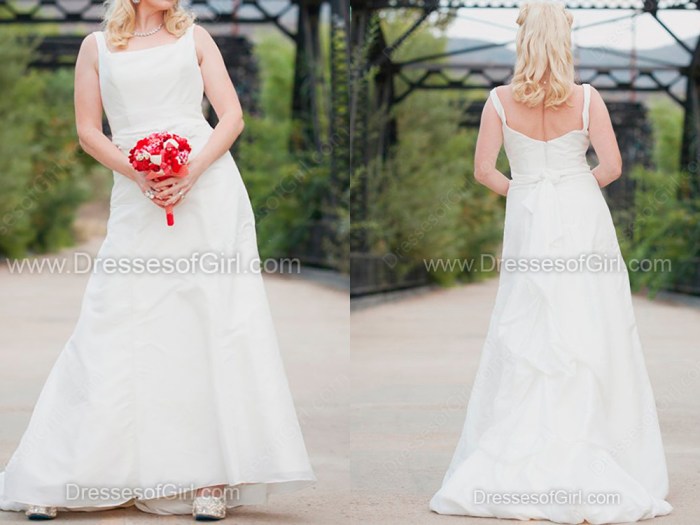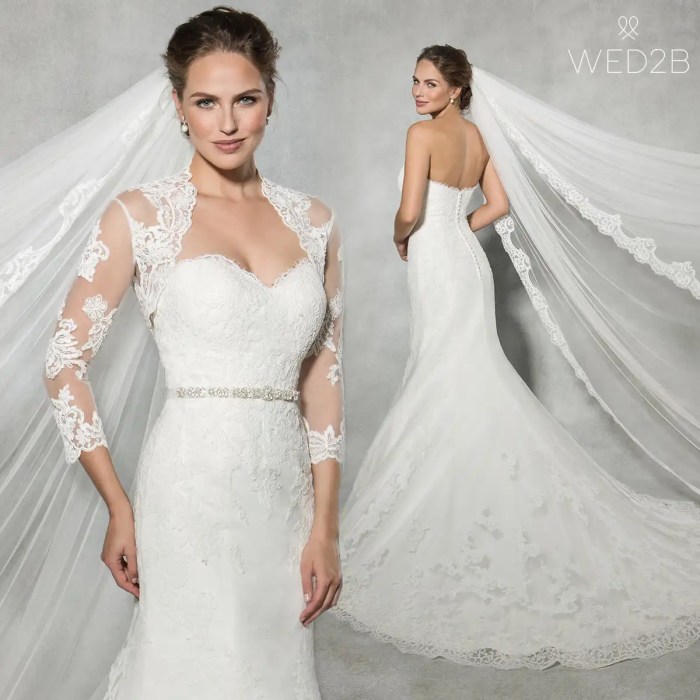Defining “Non-Traditional” in Plus-Size Wedding Dresses

Source: staticflickr.com
Plus size non traditional wedding dresses – The term “non-traditional” in plus-size wedding dresses signifies a departure from the classic, often restrictive, styles historically associated with bridal wear. It embraces individuality and celebrates a bride’s unique style and body shape, moving beyond the constraints of conventional silhouettes and embellishments.
Characteristics of Non-Traditional Plus-Size Wedding Dresses
Non-traditional plus-size wedding dresses are characterized by their bold choices in silhouette, color, and fabric. They often feature unconventional necklines, sleeves, and lengths, moving away from the typical A-line or ballgown styles. Instead, they might incorporate unique details like plunging necklines, dramatic sleeves, or unexpected color palettes.
Design Elements Contributing to a Non-Traditional Aesthetic
Design elements that contribute to a non-traditional aesthetic include unconventional silhouettes like empire waistlines, fit-and-flare dresses with defined waists, or sleek sheath dresses. Bold colors, beyond the traditional white or ivory, such as blush pink, deep red, or even navy blue, add a modern twist. Unique fabrics like velvet, brocade, or metallic lace create a luxurious and distinctive look.
Comparison of Traditional and Non-Traditional Plus-Size Wedding Dress Styles
The table below highlights the key differences between traditional and non-traditional plus-size wedding dress styles.
| Traditional | Non-Traditional | |
|---|---|---|
| Neckline | Sweetheart, bateau, high neck | Plunging V-neck, halter, off-the-shoulder |
| Silhouette | A-line, ballgown, empire waist | Sheath, mermaid, fit-and-flare, tea-length |
| Fabric | Tulle, satin, organza | Lace, velvet, silk, brocade, chiffon |
| Embellishments | Minimal beading, simple lace | Intricate beading, embroidery, appliqués, feathers |
Popular Non-Traditional Styles for Plus-Size Brides
Several non-traditional styles cater specifically to the needs and preferences of plus-size brides, emphasizing comfort, elegance, and individual expression.
Bohemian Plus-Size Wedding Dress
This style typically features flowing fabrics like chiffon or lace, often with a relaxed, empire waistline or A-line silhouette. The neckline can be V-neck, off-the-shoulder, or even a simple scoop neck. Sleeves are usually long and flowing, or three-quarter length, creating a romantic and ethereal look. This style suits various body types, particularly those who appreciate a less structured, more relaxed fit.
It’s perfect for outdoor or rustic weddings.
Modern Plus-Size Wedding Dress
This style prioritizes clean lines, sleek silhouettes, and sophisticated detailing. Common features include a sheath or column silhouette, a high neck or a simple V-neck, and minimal embellishments. The fabric is often structured, such as crepe or mikado silk. This style is ideal for brides who want a contemporary, minimalist look. It suits most body types, particularly those who appreciate a more streamlined aesthetic.
This is perfect for a modern or city wedding.
Romantic Plus-Size Wedding Dress
This style emphasizes soft fabrics, delicate embellishments, and romantic details. It often features a flowing A-line or ballgown silhouette, a sweetheart or off-the-shoulder neckline, and delicate lace or floral appliqués. The sleeves can be long, three-quarter length, or even off-the-shoulder. This style is flattering on most body types and is ideal for a traditional or romantic wedding setting.
Fabric and Detail Choices for Plus-Size Non-Traditional Gowns
The choice of fabric and embellishments significantly impacts the overall look and feel of a plus-size non-traditional wedding dress. Careful consideration should be given to the drape, comfort, and overall effect of each option.
Fabric Suitability for Plus-Size Non-Traditional Dresses
- Lace: Pros: Romantic, delicate, versatile; Cons: Can be heavy, may require careful layering to avoid transparency.
- Silk: Pros: Luxurious, drapes beautifully, breathable; Cons: Can be expensive, requires careful cleaning.
- Chiffon: Pros: Lightweight, flows beautifully, affordable; Cons: Can be sheer, may wrinkle easily.
- Velvet: Pros: Rich, luxurious, adds warmth; Cons: Can be heavy, may show imperfections.
- Crepe: Pros: Structured, drapes well, hides imperfections; Cons: Can be less forgiving on body shape if not properly fitted.
Impact of Embellishments
Embellishments such as beading, embroidery, and appliqués add texture, depth, and visual interest to a non-traditional plus-size dress. However, it’s crucial to choose embellishments that complement the overall style and avoid overwhelming the design.
Accessorizing Non-Traditional Plus-Size Wedding Dresses
Accessories play a crucial role in completing the look of a non-traditional plus-size wedding dress. They can enhance the overall style, add personality, and create a cohesive aesthetic.
Accessorizing Styles for Non-Traditional Plus-Size Dresses, Plus size non traditional wedding dresses
Style 1: Bohemian Chic: A flowing chiffon dress with a floral crown, delicate layered necklaces, and ankle-length boots. The overall effect is relaxed, romantic, and effortlessly stylish.
Style 2: Modern Minimalist: A sleek crepe sheath dress paired with simple stud earrings, a delicate bracelet, and a modern geometric clutch. This look is clean, sophisticated, and understated.
Style 3: Romantic Glam: A lace A-line dress accessorized with a cathedral-length veil, statement earrings, and a sparkling belt. This creates a glamorous and romantic look.
Finding and Purchasing Plus-Size Non-Traditional Wedding Dresses
Finding the perfect plus-size non-traditional wedding dress requires careful planning and research. There are numerous avenues to explore, each offering unique advantages.
Sources for Plus-Size Non-Traditional Wedding Dresses
Brides can find plus-size non-traditional wedding dresses at online retailers specializing in plus-size bridal wear, local boutiques that carry a diverse selection of styles, and even through independent designers who create custom gowns.
Tips for Finding a Well-Fitting Dress
It’s crucial to find a dress that not only fits well but also flatters the bride’s body type. Consider professional fittings and alterations to ensure a perfect fit. Look for dresses with supportive elements and fabrics that drape well.
Budgeting and Purchasing Process
Set a realistic budget and research pricing before starting the search. Be aware of additional costs, such as alterations and accessories. Read reviews and compare prices before making a purchase.
Styling Considerations for Plus-Size Non-Traditional Brides: Plus Size Non Traditional Wedding Dresses

Source: wed2b.com
Completing the look of a non-traditional plus-size wedding dress involves thoughtful hair and makeup choices, appropriate undergarments, and professional alterations.
Finding a plus size non-traditional wedding dress can be surprisingly challenging, but there are options beyond the usual bridal boutiques. For a comfortable and stylish alternative, consider exploring options like those offered by well-known brands; a great place to start your search might be checking out the selection of j jill dresses for wedding , known for their inclusive sizing and variety of elegant styles.
Ultimately, the goal is to find a dress that reflects your unique personality and feels amazing, regardless of the traditional expectations.
Hair and Makeup
Hair and makeup should complement the dress and the overall wedding style. Consider a loose, romantic updo for a bohemian dress, a sleek chignon for a modern gown, or a glamorous updo with soft curls for a romantic dress.
Undergarments
Choosing the right undergarments is essential for support, shaping, and ensuring a smooth silhouette under the dress. Consider shapewear or a well-fitting bra that provides the necessary support without creating visible lines.
Alterations and Fittings
Professional alterations are crucial to ensure the dress fits perfectly and flatters the bride’s figure. Find a skilled seamstress who has experience working with plus-size garments.
FAQ Compilation
What are some common misconceptions about plus-size wedding dresses?
A common misconception is that plus-size brides have limited style options. In reality, there’s a vast array of styles, fabrics, and designs available to flatter every body type.
How can I find a seamstress experienced with plus-size alterations?
Ask for recommendations from bridal boutiques or other plus-size brides. Online reviews can also be helpful in identifying skilled and experienced seamstresses specializing in plus-size alterations.
Where can I find affordable plus-size non-traditional wedding dresses?
Consider online retailers, sample sales, consignment shops, and even gently used wedding dress stores. Setting a realistic budget and shopping strategically can help you find a beautiful dress without breaking the bank.
How far in advance should I start shopping for my wedding dress?
Ideally, begin shopping 9-12 months before your wedding to allow ample time for alterations and potential delays. Plus-size dresses may require more extensive alterations, so starting early is recommended.
